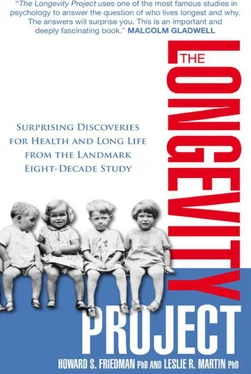Patricia and James both bounced back—they lived long lives despite having faced a significant risk factor during their childhoods. Their own marriages—James to Irene after a whirlwind courtship, and Patricia to Charles after a cautious and lengthy engagement—were fulfilling, and almost surely played an important role in promoting their longevity.
Both James, the tactful, charismatic one, and prudent Patricia reported that they had many interests in common with their spouses and viewed their marriages as decidedly above average. They also clearly said that if they were to do it all over again, they would choose the same person to marry. (This marital match is not insignificant, as we will see when we examine marriage in detail.) Neither Patricia nor James smoked, neither had been sorely disadvantaged by the parental divorce in terms of their socioeconomic status, and both had completed a good education. Patricia had gone straight through a four-year college and almost immediately started working as a claims adjuster for a well-respected insurance company. James, despite a few setbacks, had eventually completed a four-year degree. All of these were relevant to their longevity. Yet we sensed there might be something else in play.
From looking at the Terman subjects’ pathways to long life, we surmised that something about their childhood family environments must be somehow relevant to their health over the long haul. Fortunately, Dr. Terman, the test-everything empiricist, had collected information about whether they were psychologically attached to their parents, how much admiration and affection they felt for each parent, and how helpful their parents had been to them. We put such questions together as a means of measuring positive family environment. It turned out that positive family attributes were more likely to be found in the intact families than in the parental divorce group. This was not surprising. What was surprising was what mattered to those who faced parental divorce.
A good deal of research by others points to the potential long-term problems associated with what are sometimes called risky families—homes that lack nurturance and are instead characterized by conflict. 39 39 For more about risky families see R. L. Repetti, S. E. Taylor, and T. E. Seeman, “Risky Families: Family Social Environment and the Mental and Physical Health of Offspring,” Psychological Bulletin 128 (2002): 330-66.
We wondered if children coming from such at-risk environments—parental divorce and lack of positive family feelings—might be especially vulnerable, and conversely whether more positive family environments might serve as a kind of buffer for those facing a parental split.
Positive family characteristics were not at all important in the way we had expected. For the boys in the parental divorce group, positive family feelings were harmful to the boys—such boys lived shorter lives. 40 40 You can read more about our findings on family environment and parental divorce in L. R. Martin, H. S. Friedman, K. M. Clark, and J. S. Tucker, “Longevity following the Experience of Parental Divorce,” Social Science and Medicine 61 (2005): 2177-89.
It was especially traumatic to have a seemingly positive, functional home torn apart. In contrast, for cases where the family was clearly troubled, the outcome proved to be something of a relief. 41 41 For further research on effects of divorce over time see P. R. Amato, L. S. Loomis, and A. Booth, “Parental Divorce, Marital Conflict, and Offspring Well-Being during Early Adulthood,” Social Forces 73 (1995), 895-915.
This finding is in line with the sometimes-heard recommendation that staying married for the sake of the children is usually not a good idea. We would clarify this recommendation, however, by adding that staying married for the sake of the children is usually not a good idea if the family environment is a distressed and unhappy one .
For girls, this aspect of family life was not relevant to their later longevity. To be honest, we don’t know why. But as we will see later on, different things were often more relevant to the health and longevity of the Terman men than to the Terman women.
The Power of Bouncing Back
Beyond having healthy marriages and avoiding cigarettes and other dangerous habits, Patricia and James—the survivors—had something else in common. In 1950 they and other resilient subjects reported deep satisfaction and interest in their vocations and felt they had lived up to their intellectual abilities. Contrast this with Philip, who, you will recall, reported that he hadn’t lived up to his potential and that although he wasn’t totally discontented with his career, neither did he find it wholly satisfying.
This sense of being satisfied with one’s life and achievement was very relevant to resilience. The Terman participants (especially men) who found a sense of personal satisfaction and accomplishment by midlife were buffered against the ill effects of their childhood traumas. This may sound commonsensical. The startling twist, however, was that this sense of satisfaction predicted longer life spans only for those whose parents had divorced. Although the rest—those whose parents had stayed married—surely felt good about their accomplishments (or bad about their lack of accomplishments), that sense of satisfaction did not at all affect their mortality risk. This protective strength—this added health-relevant maturity—emerged in the presence of the challenge of parental divorce. Individuals who were able to call up resilience in order to overcome hardship had longer lives.
So there really is something to say for becoming stronger by overcoming adversity. An interesting side note is that most studies of stress and resilience could never uncover such a finding, because they would not be able to make the necessary comparisons. Most studies of individuals facing trauma or stress would endeavor to see who is resilient, but would not include individuals who were not facing trauma, divorce, or stress. As such, they wouldn’t be able to tell us whether protective patterns are generally helpful in facing life’s challenges or just valuable to those facing a special or intense stress.
Was there perhaps also something about the temperaments or personalities of certain Terman subjects that helped make them resilient? Did some children have internal qualities that helped them withstand the pummeling of a troubled home? These aren’t novel questions: other researchers have found evidence that individual factors, some of which are genetic, contribute to the negative outcomes associated with experiencing parental divorce. 42 42 For more on possible genetic contributions to outcomes following parental divorce see B. M. D’Onofrio, E. Turkheimer, R. E. Emery, W. S. Slutske, A. C. Heath, P. A. Madden, and N. G. Martin, “A Genetically Informed Study of the Processes underlying the Association between Parental Marital Instability and Offspring Adjustment,” Developmental Psychology 42, no. 3 (2006): 486-99.
That is, children with difficult temperaments seem to have more trouble adapting to change and also tend to elicit negative emotions and behaviors from others, whereas those with easy temperaments garner less negativity and cope better with what they do experience.
We therefore looked to see whether the Terman subjects’ personalities could be moderating the effect—influencing their experience of, and reaction to, the dissolution of their parents’ marriage in a way that was relevant to their life-span mortality risk. Were some just born resilient? Not at all. Just as their personalities were not causing their parents’ breakups, those who matured and became satisfied with their lives and their work did so because they found some strength of character, not because of their temperament or personality. Resilience was cultivated throughout their early adult years; they grappled with the challenge, overcame it, and went on to live long lives.
Читать дальше











